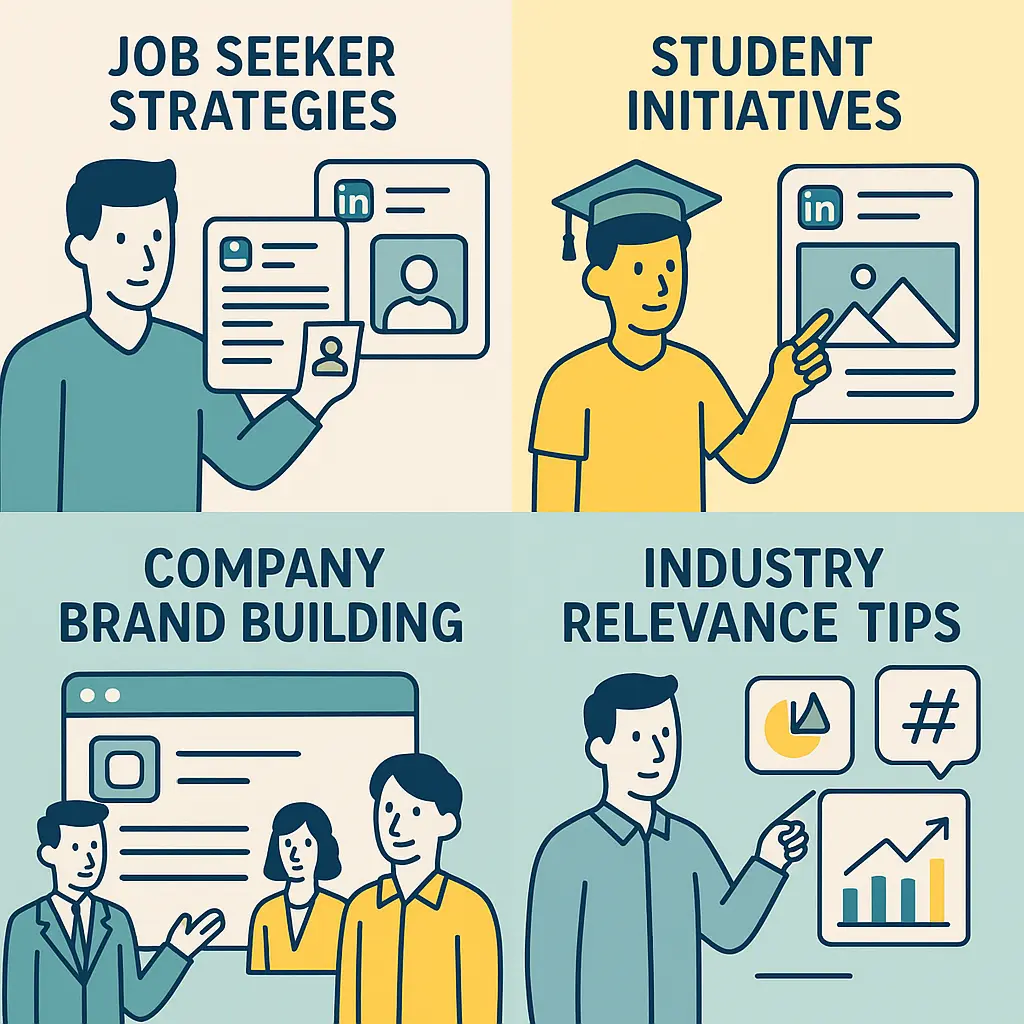
LinkedIn is a powerful tool for professionals. It connects you with industry peers and potential employers. But what should you post to make an impact?
Crafting the right content is key to standing out and staying relevant. Your posts should match your career goals and connect well with your network. Whether sharing industry insights or personal stories, the possibilities for meaningful content are vast. Adding visual elements like infographics can significantly boost engagement, and offering your perspective on trending topics can increase your visibility. Above all, consistency is crucial for maintaining a strong and lasting presence.
This guide will explore what to post on LinkedIn to enhance your professional brand.
Why LinkedIn Content Matters for Your Professional Brand
- Crafting compelling content on LinkedIn is essential for professional success. It showcases your expertise and builds your brand.
- High-quality posts can establish you as a thought leader in your industry. They attract like-minded professionals and boost your network.
- Your content reflects your professional persona. It can influence how others see your capabilities and accomplishments.
- Consistent, relevant posts keep you visible in a crowded network. They help maintain and grow valuable connections.
Consider these benefits of effective LinkedIn content:
- Enhances credibility with insightful, well-researched posts.
- Builds connections by promoting talks and interaction.
- Boosts visibility through strategic use of hashtags and trends.

Understanding Your LinkedIn Audience
Knowing your LinkedIn audience is crucial for crafting content that resonates. This understanding drives engagement and connection.
Start by analyzing your network’s demographics. Consider their professional roles, industries, and interests. Understanding these details helps tailor your content. When your posts align with their needs, they’re more likely to engage.
To define your audience, consider:
- Their professional goals and challenges.
- The kind of content they frequently interact with.
- Trends and topics relevant to them.
Aligning your posts with these insights ensures you address their interests and contribute valuable discussions.
The Best Types of LinkedIn Posts (With Examples)
To maximize your LinkedIn presence, share diverse types of posts. From industry news to personal achievements, each post can serve a unique purpose.
Strategically crafted posts boost engagement and help you reach your professional goals. Each type targets different audience needs.
Let’s delve into specific LinkedIn post ideas that can elevate your profile. Real-world examples will illustrate how to implement these strategies effectively.
1. Industry News and Insights
Sharing industry news positions you as a thought leader. It shows you are informed and proactive. Curate content that covers recent advancements. Discuss the implications of these updates for your industry.
This type of post establishes your credibility. Use bullet points to highlight key takeaways:
- Current trends affecting your field.
- Innovations that could change the market.
- Regulatory changes impacting the industry.
2. Personal Success Stories and Career Milestones
Personal success stories inspire your network. Share achievements like promotions or new skills acquired. Authentic storytelling resonates with your audience. It shows vulnerability and growth. Sharing milestones helps others join in your celebrations.
Use a list to showcase what you’ve achieved:
- Significant career milestones.
- New certifications or skills.
- Overcoming professional challenges.
3. Company Updates and Announcements
Company updates keep your network informed. Celebrate achievements or share crucial announcements. These posts maintain transparency. They also strengthen your connection with your network.
Important updates might include new hires or product launches. Summarize the key points to keep your audience engaged:
- New partnership announcements.
- Company growth milestones.
- Major projects underway.
4. Tips, How-To Guides, and Educational Content
Educational content provides immense value. Share tips or step-by-step guides relevant to your industry. These posts establish you as a helpful resource. They encourage your network to engage and share.
Using bullets can outline the major points or steps clearly:
- Practical tips for industry challenges.
- Step-by-step how-to guides.
- Best practices in your field.
5. Thought Leadership and Opinion Pieces
Opinion pieces let you share insights. Expressing ideas on industry challenges shows leadership. These posts open discussions. Invite your network to share their thoughts.
Key elements of a strong opinion post include:
- Personal insights on trends or innovations.
- Solutions to common industry problems.
- Predictions about the future of your field.
6. Visual Content: Infographics, Videos, and Carousels
Visual content grabs attention. Infographics, videos, and carousels convey complex information effectively. These formats increase engagement. Use visuals to simplify data and make it accessible.
Types of visual content you can share:
- Infographics summarizing key data points.
- Videos explaining new concepts.
- Carousel posts showcasing multiple images.
7. Polls, Questions, and Interactive Posts
Interactive posts drive engagement. Polls and questions invite your network to contribute. These posts gather insights. They show you value your audience’s opinions.
Examples of interactive content:
- Polls on industry trends.
- Open questions about common challenges.
- Invitations to share personal experiences.
8. User-Generated Content and Testimonials
User-generated content builds trust. Share testimonials from clients or partners. These posts prove your credibility. They showcase real-world impact of your work.
Key types of user-generated content include:
- Client testimonials highlighting success.
- Partner reviews of collaborative efforts.
- User stories showing product benefits.
9. Team Spotlights and Employee Stories
Highlighting your team boosts morale. Employee stories humanize your brand. These posts showcase company culture. They can also help attract talent.
Consider sharing:
- Spotlights on team achievements.
- Personal stories from employees.
- Recognition of outstanding efforts.
10. Event Highlights and Professional Development
Event highlights expand your network. Share learnings from conferences or workshops. These posts position you as a lifelong learner. They also encourage professional interactions.
When sharing about events, include:
- Insights gained from the event.
- Key speakers and topics covered.
- Networking opportunities leveraged.
11. Book Recommendations and Learning Resources
Book recommendations inspire knowledge sharing. Share books that impact your career. These posts reflect your commitment to learning. They can also prompt valuable discussions.
When recommending books, include:
- Key takeaways or insights.
- Relevance to your industry.
- Personal impact of the book.
12. Celebrating Industry Events and Special Days
Celebrating industry events shows involvement. Highlight special days that matter. These posts connect you with peers. They express dedication to your field.
Consider marking:
- Industry-specific appreciation days.
- Anniversaries of key developments.
- Global observances relevant to your work.
13. Free Resources, Tools, and Templates
Free resources provide value. Share tools or templates useful to your audience. These posts can boost engagement and loyalty. They position you as a resourceful contact.
Offer:
- Templates for specific tasks.
- Tools for improving efficiency.
- Resources for learning or growth.
14. Behind-the-Scenes and Company Culture
Behind-the-scenes content reveals your company culture. These posts make your brand relatable. Highlighting daily operations can humanize your business. It also fosters transparency.
Share:
- Behind-the-scenes looks at the workplace.
- Snapshots of team activities.
- Insights into company values.
15. Diversity, Inclusion, and Social Responsibility
Emphasizing diversity shows values. Share initiatives or philosophies on inclusion. These posts build your brand image. They demonstrate corporate responsibility.
Key topics to cover:
- Diversity and inclusion programs.
- Social responsibility initiatives.
- Community involvement projects.
16. Motivational Quotes and Messages
Motivational quotes lift spirits. Share inspiring messages that resonate with your network. These posts can spur engagement. They encourage positivity and forward-thinking.
Consider including:
- Quotes from industry leaders.
- Messages related to personal growth.
- Encouraging words for professional challenges.
17. Career Advice and Mentorship Opportunities
Career advice showcases leadership. Offer mentorship or share professional tips. These posts promote growth. They attract followers seeking guidance.
Share advice on:
- Navigating career challenges.
- Developing professional skills.
- Finding mentorship opportunities.
18. Product Launches and Service Updates
Announce new products to generate interest. Share updates to keep your network informed. These posts can lead to potential leads. They demonstrate innovation and progress.
Include:
- Launch dates and features.
- User benefits and improvements.
- Invites to test or review.
19. Case Studies and Success Stories
Case studies prove expertise. Share detailed success stories from your projects. These posts provide validation. They highlight your work’s impact.
Key elements to include:
- Challenges addressed and solutions implemented.
- Results and benefits achieved.
- Testimonials from those involved.
20. Sharing Failures and Lessons Learned
Discussing failures fosters learning. Share what you learned from setbacks. These posts humanize your brand. They encourage openness and growth.
Include in your posts:
- Challenges faced and actions taken.
- Lessons learned from the experience.
- Future strategies to improve.
LinkedIn Post Ideas for Specific Goals

LinkedIn strategies differ depending on your goals. Tailor your content to align with your aspirations. Whether you’re a job seeker, student, or company, choosing the right content is key.
Identify your objective, and adapt your posts to achieve it. This tailored approach enhances your LinkedIn presence. Here’s a breakdown by goal type, offering a quick reference:
- Job seeker strategies
- Student initiatives
- Company brand building
- Industry relevance tips
What to Post on LinkedIn as a Job Seeker
Job seekers can use LinkedIn to highlight skills and experiences. Focus on showcasing your unique strengths to attract potential employers.
Post about your job search and industry passion. Suggested posts include:
- Key projects you’ve worked on.
- Skills and certifications gained.
- Network connections and feedback.
What to Post on LinkedIn as a Student or Recent Graduate
Students should highlight educational achievements and aspirations. Focus on projects, internships, and skills you’ve developed.
Such content can attract mentors and opportunities. Consider sharing:
- Major projects and presentations.
- Relevant coursework or degrees.
- Extracurricular activities and leadership roles.
What to Post on a LinkedIn Company Page
Company pages should focus on brand building and engagement. Highlight company culture, updates, and industry insights.
This approach strengthens brand reputation. Key post ideas include:
- Innovations and product developments.
- Employee spotlights and achievements.
- Corporate events and industry participation.
What to Post to Stay Relevant in Your Industry
Remaining relevant means staying informed and engaged. Share thoughts on industry trends and developments to demonstrate thought leadership.
This keeps your network engaged and informed. Types of posts to consider:
- Insights on industry disruptions.
- Commentary on trending topics.
- Innovative ideas and solutions.
LinkedIn Content Best Practices
Creating good content for LinkedIn means knowing the best ways to do it. This ensures your posts are engaging and impactful. Start by identifying your target audience and their interests.
Quality trumps quantity on LinkedIn. Focus on delivering value over frequent posting. Consistency helps maintain visibility and engagement.
When creating content, aim for authenticity and relevance. This builds trust among your network. Monitor engagement through likes, shares, and comments to refine your approach.
Maintain a professional tone that aligns with your brand. Adapt your content based on analytics insights.
- Use high-quality images and videos.
- Craft compelling headlines.
- Engage with responses.
How Often Should You Post on LinkedIn?
Posting frequency can impact visibility. Aim for a regular yet sustainable schedule. Posting a few times a week maintains engagement without overwhelming your audience.

Quality is more important than posting daily. Too much content can dilute your message. Focus on impactful content.
- Post 2-3 times per week.
- Ensure variety in content types.
- Respond to engagement promptly.
How to Write Engaging LinkedIn Posts
Creating engaging posts involves understanding your audience. Focus on clarity and relevance to capture attention. Crafting meaningful narratives can increase interaction.
Integrate personal experiences to strengthen connections. Use concise language and format your text for readability.
- Start with a strong opening.
- Include a call to action.
- Use bullet points for clarity.
What Not to Post on LinkedIn
Certain content types are inappropriate for LinkedIn. Avoid overly personal topics. Maintain professionalism and respectfulness.
Steer clear of controversial topics unless industry-relevant. Monitor comments to ensure a positive environment.
- Avoid sharing confidential details.
- Don’t post irrelevant personal stories.
- Refrain from spamming promotional links.
LinkedIn Post Examples (Templates You Can Use)
Creating impactful LinkedIn posts requires a touch of creativity and strategy. Using templates can help streamline this process. They provide a starting point while allowing for personalization to suit your style. To make content creation even easier and more consistent, consider using tools like Linkify, which generate personalized post ideas tailored to your voice and professional goals.
Here are some examples to inspire your LinkedIn content creation:
Introduction and Personal Story:
- Begin with a gripping personal anecdote.
- Connect the story to a professional lesson.
- Encourage your network to share their own stories.
Industry Insight:
- Introduce a current industry trend.
- Share your expert opinion or analysis.
- Invite others to discuss their perspectives.
List of Action Points:
- Use bullet points for clarity.
- Highlight key insights or tips.
- Keep the list concise and focused.
Engagement Post Template:
- Pose a thought-provoking question.
- Share your thoughts or initial experiences.
- Ask for feedback or opinions from your network.
Do and Don’t Tips:
- Share brief guidelines on a relevant topic.
- Illustrate each point with a real-life example.
- Foster discussion by asking for additional advice.
Using these templates can enhance your LinkedIn presence by making your posts more structured and engaging. Adapt them to reflect your voice and goals, while keeping your audience in mind.
Measuring Success: Using LinkedIn Analytics
Understanding your post’s effectiveness is essential. LinkedIn Analytics provides valuable insights into your content’s impact. It helps you tailor future posts for better engagement.
Key Metrics to Track:
- Post Impressions
- Engagement Rate
- Audience Demographics
Regularly reviewing these metrics can guide your content strategy. Use analytics to identify what resonates most with your audience and refine your approach.
Final Thoughts: Building a Consistent LinkedIn Presence
Consistency is key to growing your LinkedIn presence. Regular engagement with your network is essential. Share diverse, relevant content to keep your audience interested.
Be authentic and professional in your interactions. Listen to feedback and adapt your strategies. Building a strong LinkedIn presence takes time, but with effort and the right approach, success is achievable.
